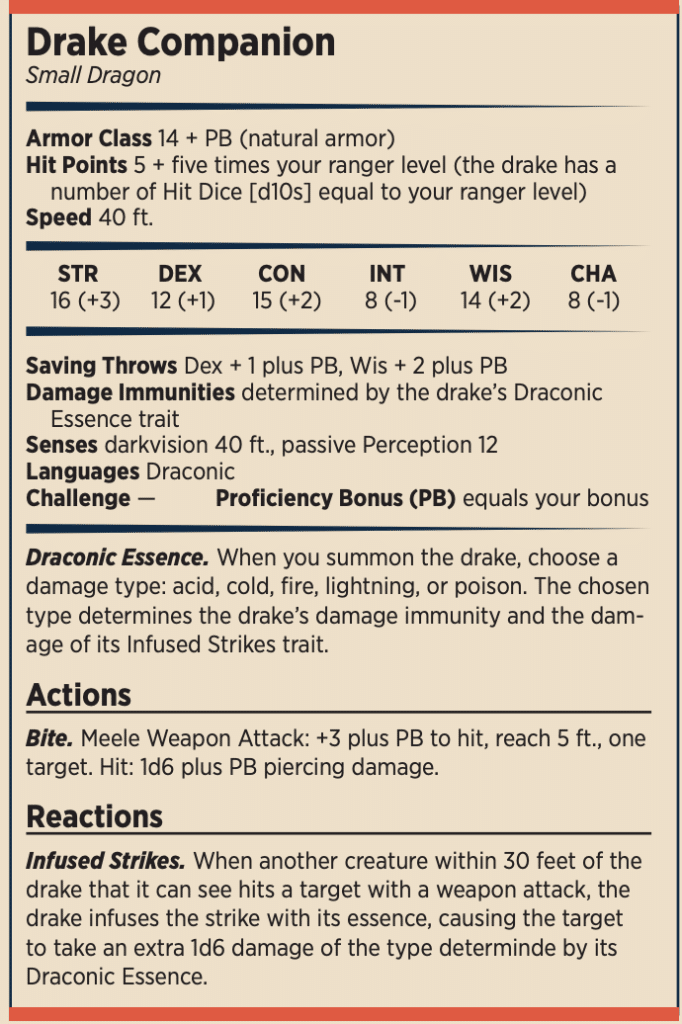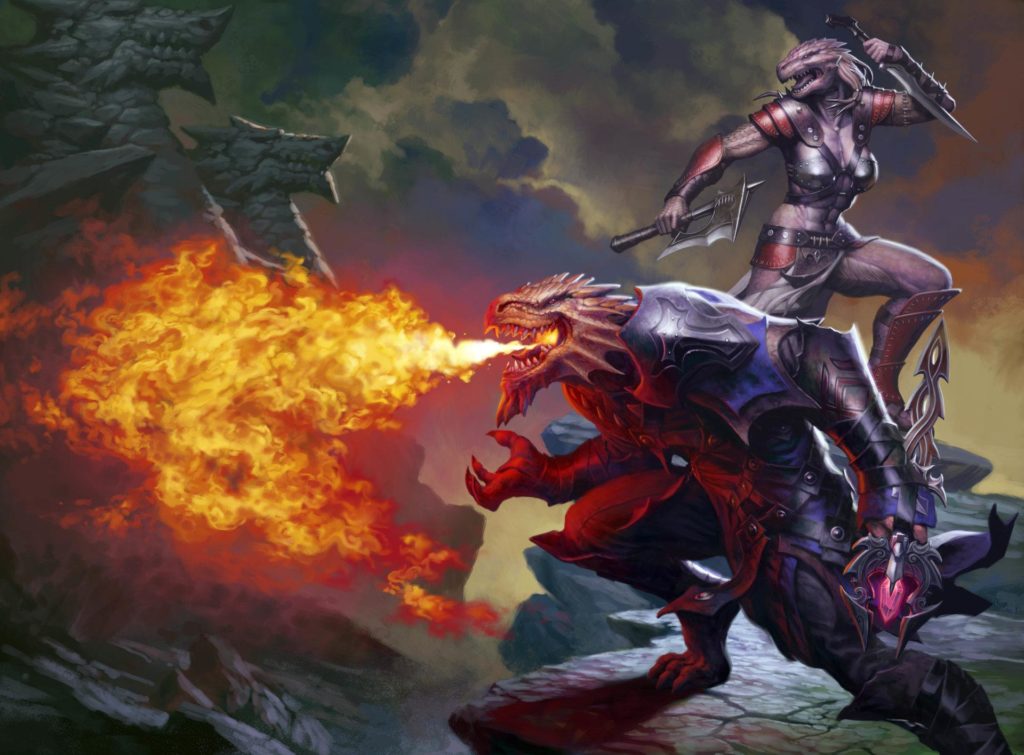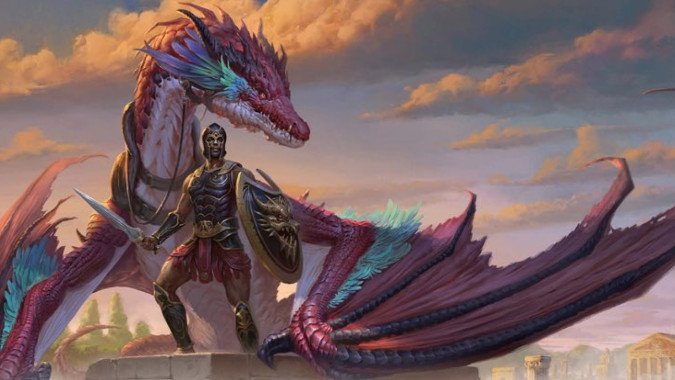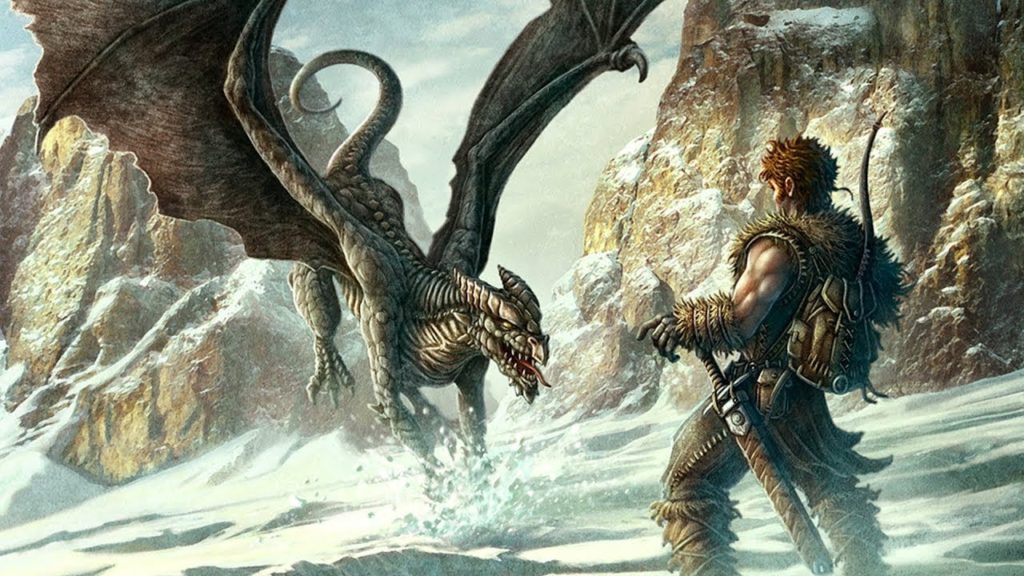Today we are going to talk about dragons.
That’s right Fizbans Treasury to Dragons is releasing on October 26th and already we already have a sneak peek at the newest subclass; Drakewarden Rangers.
While very similar to the Beastmaster Ranger, the playstyle of the two are very different.
As gone over in more detail later on in my guide, The Drakewarden Ranger is designed to be more for utility inside battle.
Meanwhile, the ranger beastmaster is designed for utility outside of battle.
In short, because of how their following abilities, the drakewarden ranger becomes a better beastmaster ranger for combat playstyles.
With that said, let’s get into the review.
How Am I Evaluating The Drake Warden Ranger Abilities?
So, before we begin the review, we should go over what I am rating and how I get my decision. There are three things that I am reviewing in the in-depth guide. I look over how strong the subclass is in combat, how much utility it has, and, if applicable, its roleplay ability. This way everyone’s playstyle can be shown to fit their needs.
Now, when deciding if something is good for a guide, I look at what the subclass is trying to accomplish. Then look at how successful it succeeds in that task. For instance, in a previous article on the Bladesinger, I concluded it attempts to make you a competitive front line. I then figure out how well that ability succeeds in letting you front line, as well as how soon it comes online.
If it is accomplished at level 2 then it is early game. Level 6 it is Early-Mid, Level 10 Late-Mid, and Level 14 is late game. I rate earlier tiers better as most Dungeon and Dragons Campaigns do not go beyond level 8. Without further adieu, let’s start this review on the drakewarden ranger.
Color Coding: Meaning
If you are curious about what the colors mean click here to see the list.
Drake Warden Ranger Verses Beastmaster
There are three things in comparison that the Beastmaster and the Drakewarden have in common.
The first is that they both gain a companion at level 3, second, being their companion is a core feature to their subclass, and the final similarity is the power of their companions.
In regards to their companions, both come online at level 3, but as discussed later on, the drakewarden ranger’s abilities are better suited for combat.
Allowing a combat viable companion to be online as early as level 3 but really comes into it level 7.
This is better than the beastmaster ranger as their battle power never really comes online.
Meanwhile, the power of the drake is better with a higher AC, HP, and damage output than the companions in Tasha’s and Players Handbook.
That said, while the drake has more power, it lacks versatility making the utility of customizable companions really shine for beastmaster rangers.
This means, that the Drakewarden will fit players looking for a more combat playstyle while beastmaster ranger goes better with people of a more utility playstyle.
So before you choose between the two figure out your playstyle and that will be the best one for you.
Drakewarden Ranger: Draconic Gift
At 3rd level for a drakewarden ranger, you get 2 abilities, the first is called Draconic Gift which states:
“The bond you share with your drake creates a connection to dragonkind, granting you understanding and empowering your presence. You gain the following benefits: You learn the thaumaturgy cantrip, which is a ranger spell for you, and you learn to speak, read, and write Draconic or one other language of your choice.
Not much to really say on this one.
The thaumaturgy cantrip is a great utility cantrip that can do a lot of things like minor illusion can.
Which, is a nice boost to the Drakewarden Rangers utility.
Moreover, gaining an additional language can be useful early on or if your party lacks a wizard.
But, this is nothing incredible so more of a flavor win than anything.
Drakewardern Ranger: Drake Companion

This is the bread and butter of the class.
Much like the beastmaster ranger, this 3rd level ability gives you access to a companion to use in and out of combat.
This ability allows you to: As an action, you can magically summon the drake that is bound to you. It appears in an unoccupied space of your choice within 30 feet of you. The drake is friendly to you and your companions, and it obeys your commands. See its game statistics in the accompanying Drake Companion stat block, which uses your proficiency bonus (PB) in several places. When you summon the drake, choose a damage type listed in its Draconic Essence trait. You can determine the cosmetic characteristics of the drake, such as its color, its scale texture, or any visible effect of its Draconic Essence; your choice has no effect on its game statistics.
In combat, the drake shares your initiative count, but it takes its turn immediately after yours. It can move and use its reaction on its own, but the only action it takes on its turn is the Dodge action, unless you take a bonus action on your turn to command it to take another action. That action can be one in its stat block or some other action. If you are incapacitated, the drake can take any action of its choice, not just Dodge.
The drake remains until it is reduced to 0 hit points, until you use this feature to summon the drake again, or until you die. Anything the drake was wearing or carrying is left behind when the drake vanishes. Once you summon the drake, you can’t do so again until you finish a long rest, unless you expend a spell slot of 1st level or higher to summon it.
Drake Companion Uses
The basics of the class is identical to the idea of the beastmaster ranger I have talked about before.
Which is that the companion, while okay for combat, excels at the utility.
The ability to have an additional familiar-like creature for any situation is extremely versatile and powerful for any given scenario.
To show this, here are 10 quick uses that you can use your Drake Companion for:
- Keeping pressure on enemies in combat
- Increase Damage output with Infused Strikes
- Cause a distraction to let you sneak by
- Lead the way to detect traps in a dungeon
- Come up with a way the drake can give you or a party member advantage
- Scout out ahead in any situation and let it report back to you in draconic
- Be a guard to let your party sleep
- Getting Flanking advantage if your campaign does that.
- Rescue party members or civilians in a situation
- Create hilarious pranks for situations.
While some are silly, this took me 5 minutes to come up with ways to use your drake companion, and there will be plenty more as you play a campaign with them.
Additionally, the ability to have a second body for a situation can be huge for controlling a battlefield.
Making this a solid utility boost inside and outside of combat.
Drakewarden Ranger: Bond of Fang & Scale
At 7th level, you get access to Bond of Fang and Scale which states:
The bond you share with your drake intensifies, protecting you and stoking the drake’s fury. When you summon your drake, it gains a swimming speed equal to its walking speed and can breathe both air and water, or it grows wings on its back and gains a flying speed equal to its walking speed (your choice). In addition, while your drake is summoned, you and the drake gain the following benefits:
Drake Mount. The drake grows to Medium size. Reflecting your special bond, you can use the drake as a mount even if your size is Medium. While you are riding your drake, it can’t use the flying speed of this feature.
Magic Fang. The drake’s Bite attack deals an extra 1d6 damage of the type chosen for the drake’s Draconic Essence.
Resistance. You gain resistance to the damage type chosen for the drake’s Draconic Essence.
Bond of Fang & Scale Evaluation
The fact that you not only gain the feature to give your drake a flying or swimming speed, but you also get three good features out of it really helps hone in on the utility of this class.
The first feature allows your drake to have a swimming or flying speed per long rest.
9 out of 10 times, you are going to choose flying, as flying is the most powerful feature anyone can have.
With Flying, Cliffs, Broken Bridges, 2nd story windows that give you access to your girlfriend’s room when her parents are home, are all obstacles easily overcome.
As a result, giving the ability to your companion will be more useful than swimming most of the time.
The second feature is the use of gaining a mount.
A little more niche in use, but is designed more for those wishing to use the Mounted Combatant feat as a ranger.
Or for those looking to increase the mobility of their character.
After all, not everyone can be a monk or barbarian with an increased movement speed.
Next, we have the 2 combat features for the Drakewarden Ranger.
These are increasing your Drake’s damage, and giving you a free resistance.
At this level, the average monster’s hit points are around 155, so dealing an extra 1d6 is not that huge.
As for resistance, fire will usually be your best bet, unless there is a more thematic or situational choice to choose.
Moreover, since this can be changed out every long rest, the use of resistance becomes much more flexible and applicable in a larger ray of uses.
Making this a solid boost to the Drakewarden Ranger’s Power.

Drakewarden Ranger: Drake’s Breath
At 11th level you gain a really cool feature that lets you:
As an action, you can exhale a 30-foot cone of damaging breath or cause your drake to exhale it. Choose acid, cold, fire, lightning, or poison damage. (Your choice does not have to match your drake’s Draconic Essence.) Each creature in the cone must make a Dexterity saving throw against your spell save DC, taking 8d6 damage on a failed save, or half as much damage on a successful one. This damage increases to 10d6 when you reach 15th level in this class. Once you use this feature, you can’t do so again until you finish a long rest, unless you expend a spell slot of 3rd level or higher to use it again.
This is my favorite ability the drakewarden ranger gets.
Drake’s Breath Why It Is Good.
While not fitting for the utility playstyle, it really increases the damage capabilities of the ranger.
Gaining a cone fireball once a day is a great opening feature.
If you can go before most of your enemies, you can cause large damage that usually only classes like wizards and sorcerers get to do,
Moreover, because this is not a spell, you can do something the ranger class is great with, casting bonus action spells.
The ranger class has the largest amount of bonus action spells for any class, which often forces the class to choose one and stick with it.
But because you now have access to a non-counterable, non-spellcasting, fireball, you can Drake’s Breath, then cast hunter’s mark, healing spirit, or lightning arrow.
Allowing you to effectively cast 2 spells in one turn.
The ability to use either your drake or yourself, change element types, and have the option to cast it more than once, allows for some great versatility to this ability.
Allowing it to be useful even in the middle of combat.
Perfected Bond
Finally, we have the final subclass ability for the drakewarden ranger; Perfected bond.
This states that:
Perfected Bond 15th-Level Drakewarden Feature Your bond to your drake reaches the pinnacle of its power. While your drake is summoned, you and the drake gain the following benefits:
Empowered Bite. The drake’s Bite attack deals an extra 1d6 damage of the type chosen for its Draconic Essence (for a total of 2d6 extra damage).
Large Drake. The drake grows to Large size. When you ride your drake, it is no longer prohibited from using the flying speed of Bond of Fang and Scale.
Reflexive Resistance. When either you or the drake takes damage while you’re within 30 feet of each other, you can use your reaction to give yourself or the drake resistance to that instance of damage.
The final ability is much like the seventh level ability in that it is designed to increase, attack, defensive, and utility uses of your drake companion.
The ability to now fly with your drake is a huge boon to your utility like mentioned before.
While more damage is nice for the class, it is by no means great as the additional damage comes out to less than 1% of a tough monster’s hp.
Making it only good for fighting the grunts in a battle.
That said, Reflexive resistance is really good. Being able to reduce the damage from one attack by half every turn is a solid boost to your survivability.
Stack that with your resistance, passing saving throws, or any other way to reduce damage your party has and big AOE attacks BBEG’s are famous for, become trivial for you.
Making you a solid tank for the party.
How to best use your drake
Once you get an understanding of the Drakewarden Rangers features, you get an understanding of how best to use your drake.
The drake is quite simply a focus for improving what your character tries to do.
Need to deal more damage? Infused strikes do a great job at that.
Or if you are trying to increase your survivability? Reflexive Resistance takes the cake.
Even if you just need utility? An extra body with flying, swimming, and a plethora of other uses will help you out immensely.
The best use for your drake is to use it to maximize one of these three builds the drakewarden ranger is built toward.
Drakewarden Ranger:Suggestions
As for suggestions when building this character, I recommend taking a look at Race, Feats, and multiclass options that might be suited for you.
Race
In regards to race
Firbolg makes an excellent combat Drakewarden ranger with a bonus to strength and wisdom and some great synergistic features with your class.
Meanwhile, Aarakocra makes great for utility playstyles due to the dex and wisdom boost combined with flying at level 1.
Finally, a Dragonborn or Kobold is incredibly on theme for a drakewarden ranger, though not very powerful in build.
All in all the Drakewarden ranger has a ton of synergy with a large swath of races making a thematic and functional race choice pretty easy.
Feats
Meanwhile, rangers also need to figure out feats for their class.
Since you are not needing your wisdom modifier for most of the subclass abilities, getting wisdom to 16 and Dex/Str to 20 should suffice.
After that, I would recommend getting:
Magic Initiate for Utility playstyles looking to add a familiar to their list of useful pets.
Aberrant Dragonmark for those looking for a roleplay boost. Also great with an odd number Con.
Also, since you are trying to control the board in combat, Alert becomes a great feat since it allows you and your drake to be set up quicker than others.
It also works great with Drakewarden ranger’s level 11 ability since enemies will not have separated yet.
Multiclass
The next thing to look at when building a Drakewarden Ranger is multiclass potential.
For a utility playstyle, nothing beats going 2 levels into wizard, especially graviturgy wizard for drake manipulations.
As for roleplay, the classic is draconic sorcerer, but I think 2-3 levels in warlock make for a great roleplay build.
Getting you not only 2 level spells every short rest, but also eldritch invocations as well.
Meanwhile, the classic, going 2-3 levels in fighter is a classic choice for combat playstyles.
Not only do they get the fighter abilities, but action surge is huge when combined with Drake’s Breath.

Drakewarden Ranger: Conclusion
In conclusion, the Drakeward Ranger is a new class I think many will love.
While at first, it has a lot of the utility a beastmaster has, I think the Drakewarden Ranger is better suited for being a combat utility playstyle.
Meaning, that their companion should focus on maximizing combat advantage with their drake.
Unlike beastmaster rangers, which should focus on more outside combat utility.
Overall, I think this definitely fits the niche many were looking for in the beastmaster ranger and as long as you keep the abilities in mind you will love playing this class.
If you are looking for a good guide to buy I highly suggest getting my Character Classes and You book.
It goes over all the bases for great character building while also going over some unique ways no one else talks about on how to make all your characters even better.
Or you can support me by buying Fizbans Treasury to Dragons by purchasing the book through my link.
It goes a long way for helping me keep doing these reviews.

